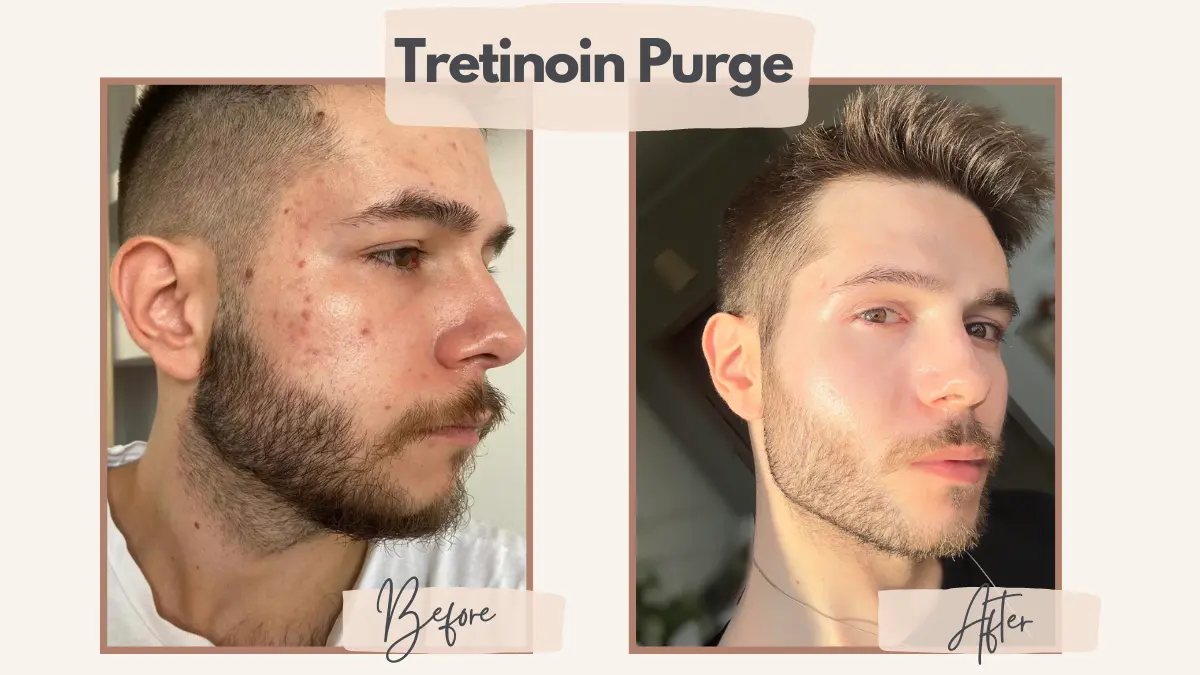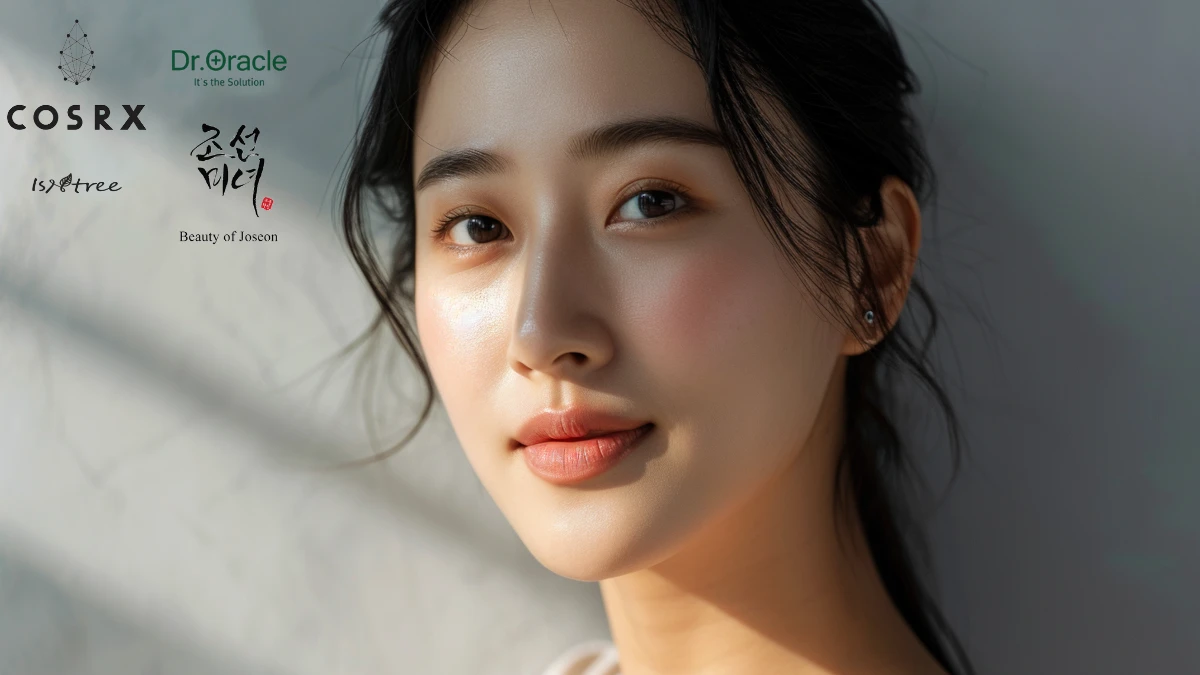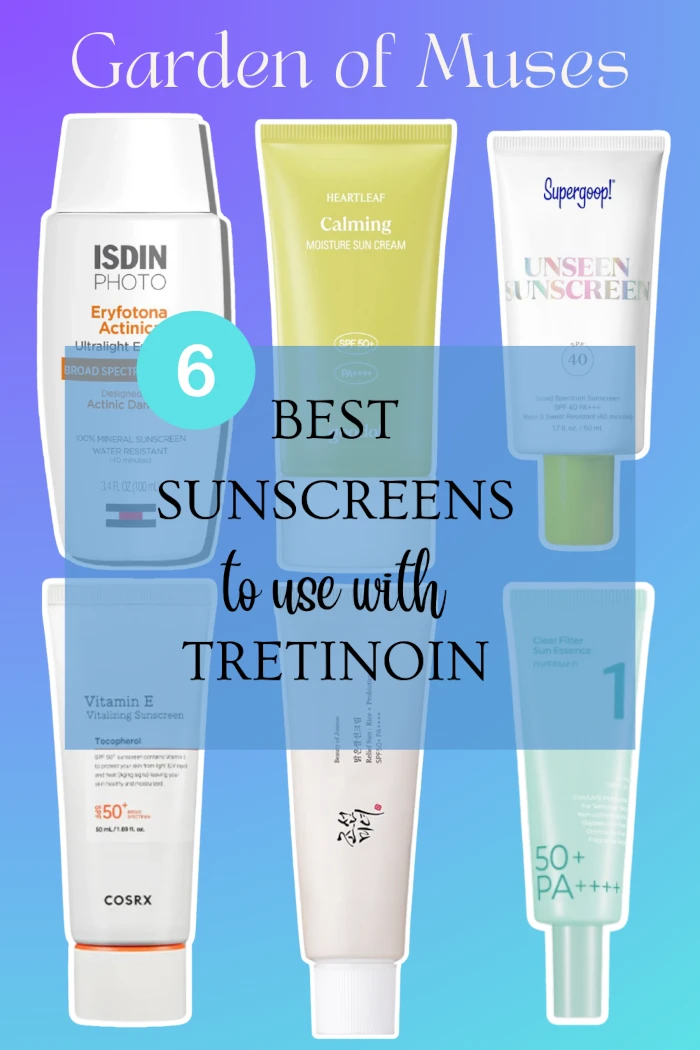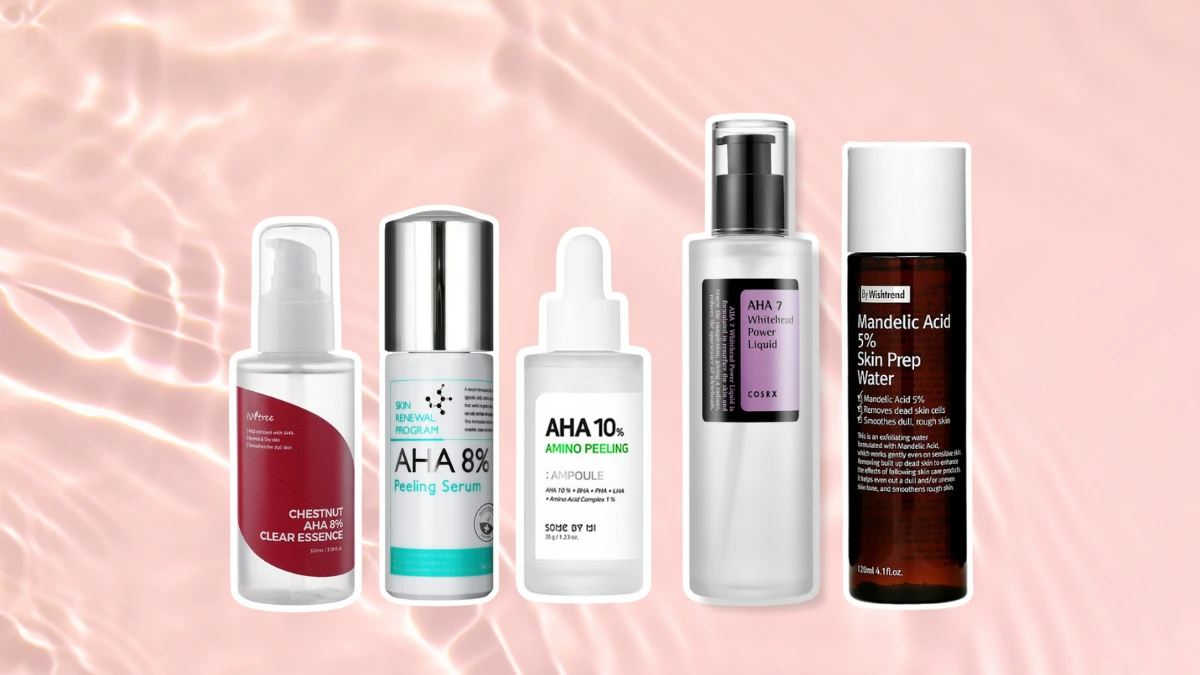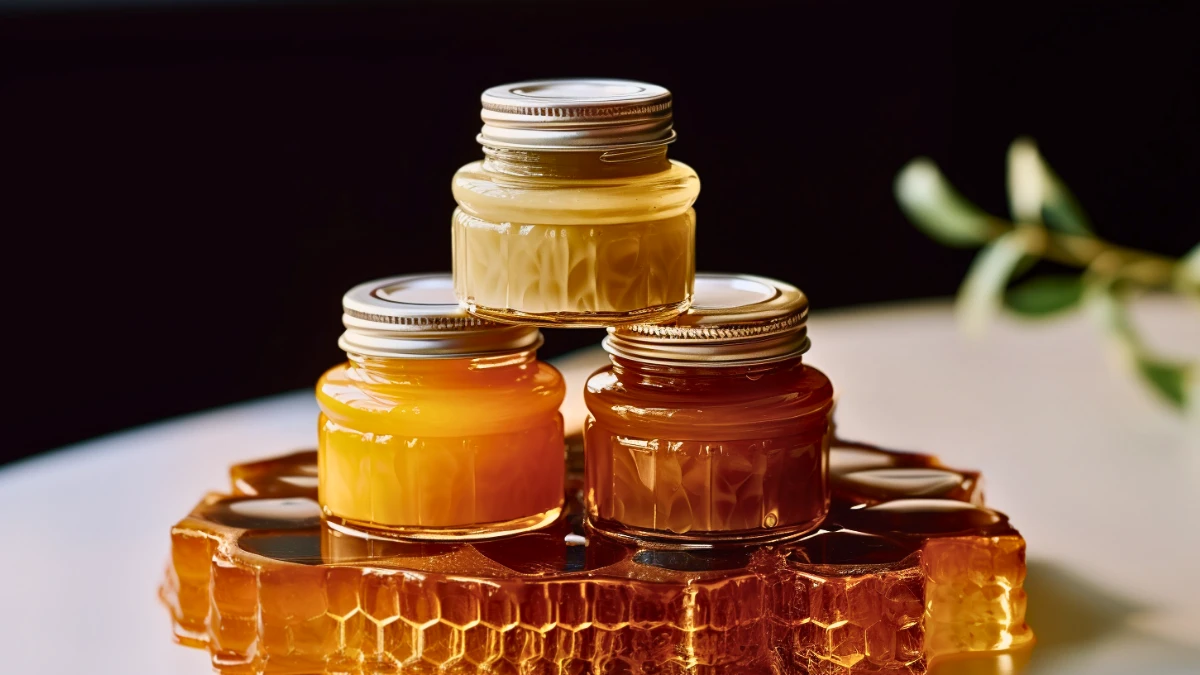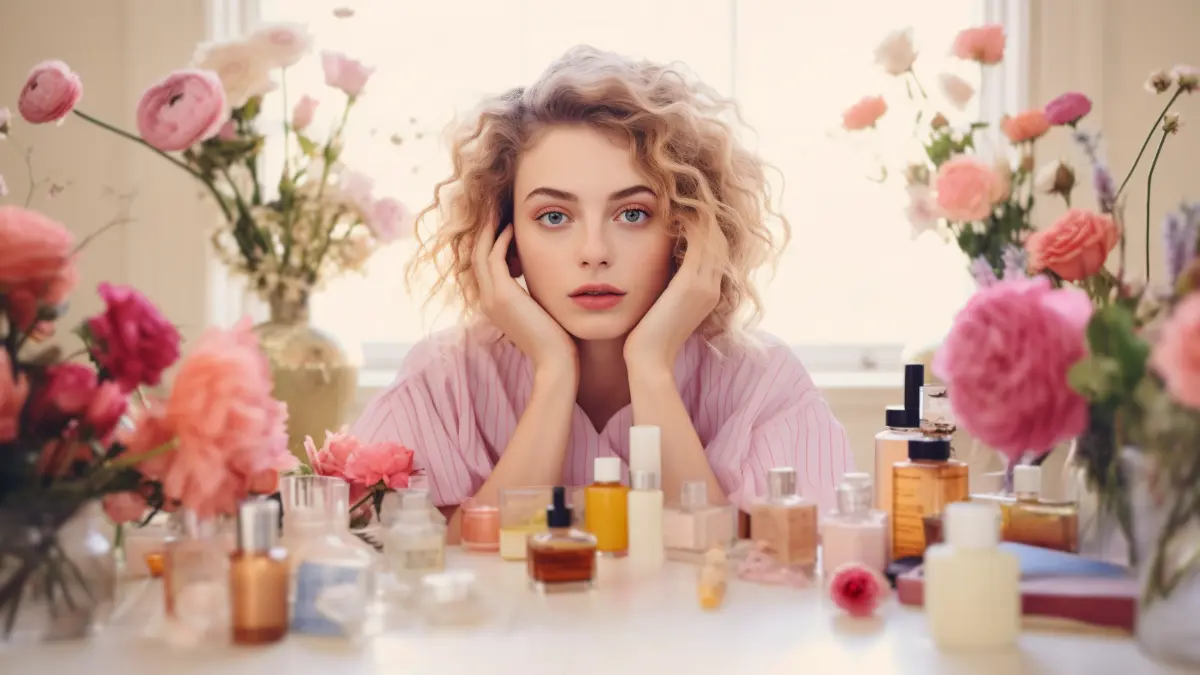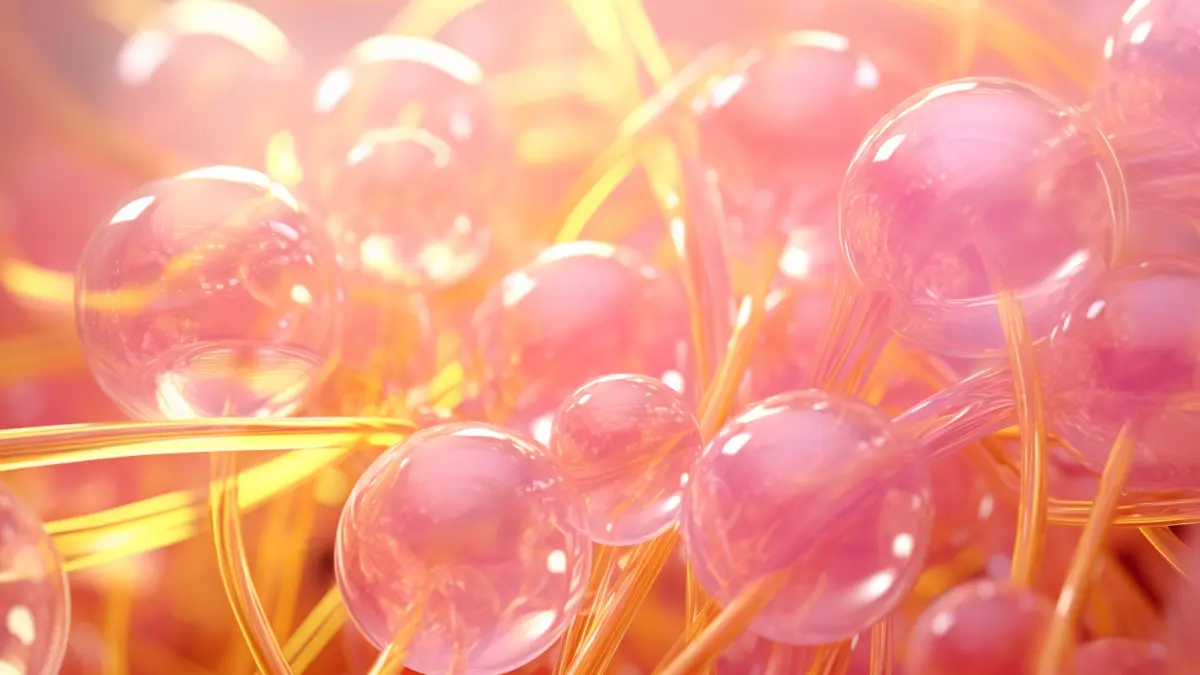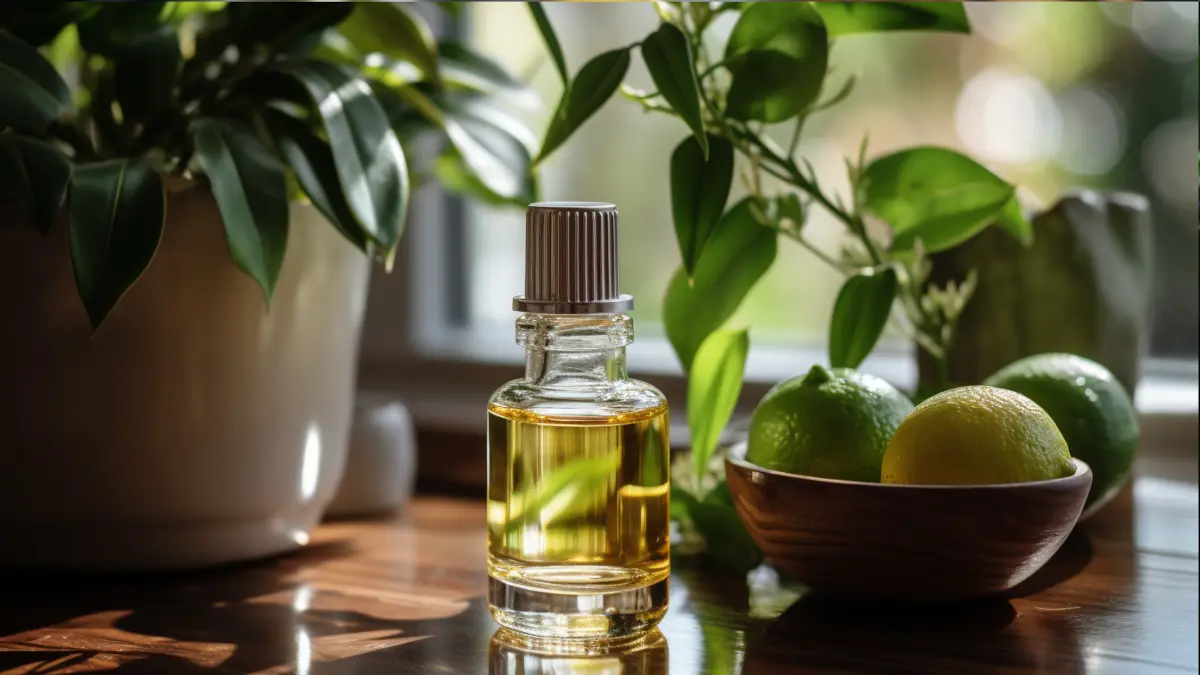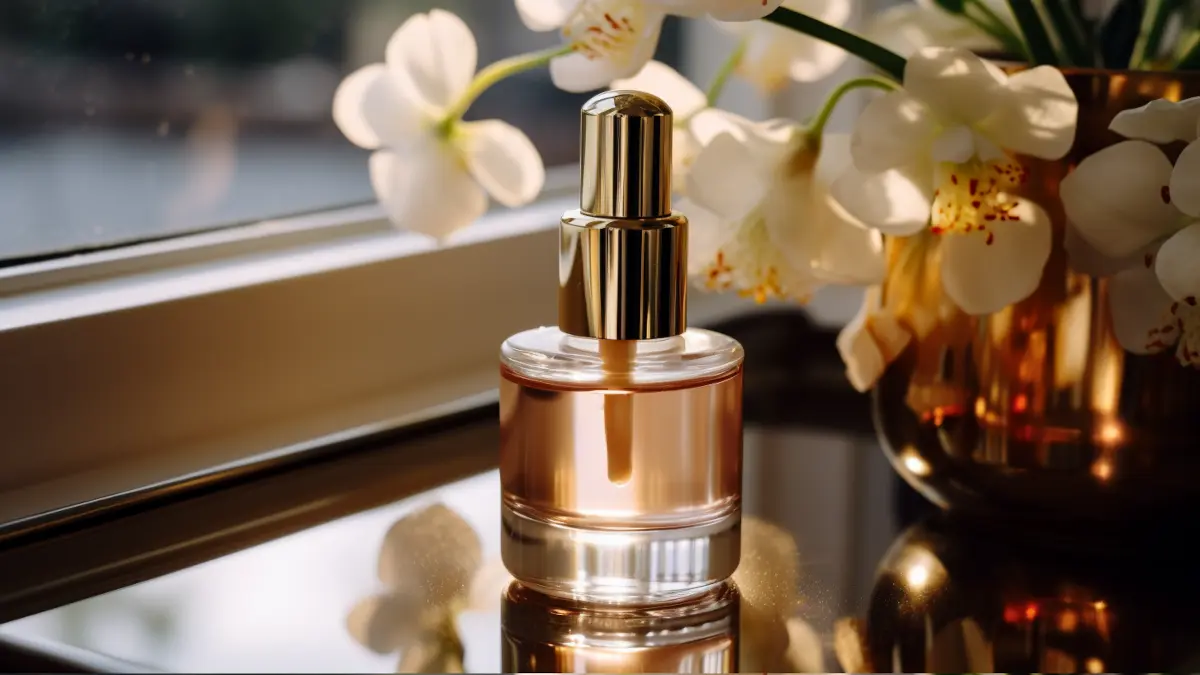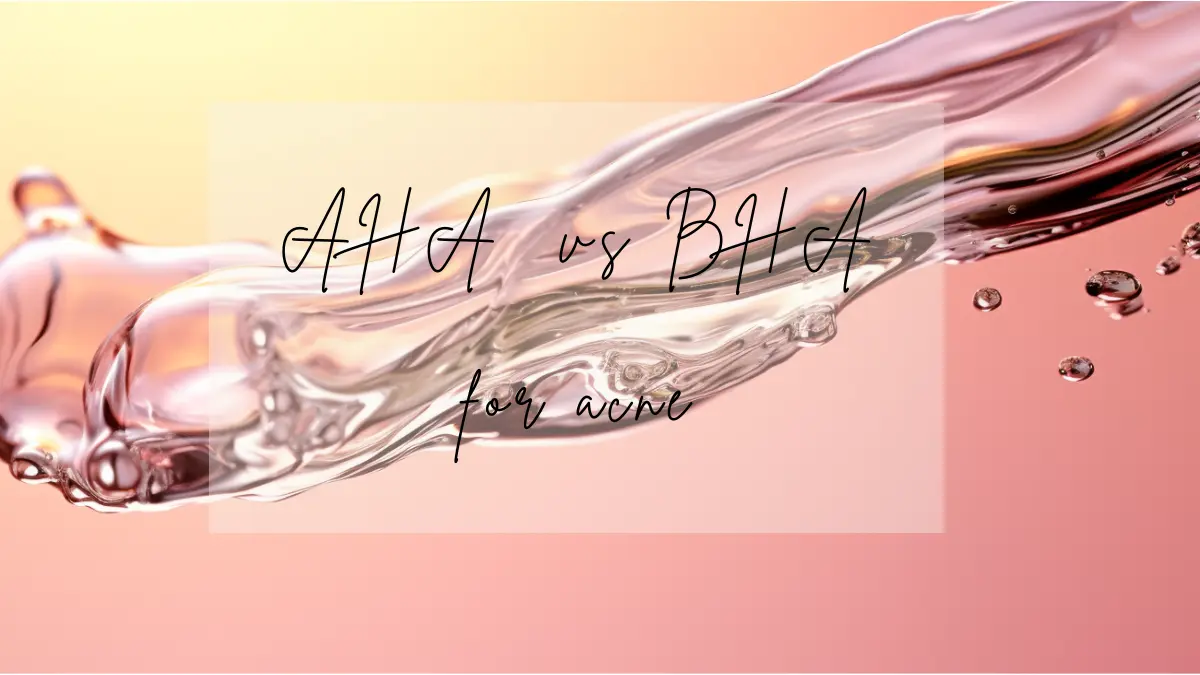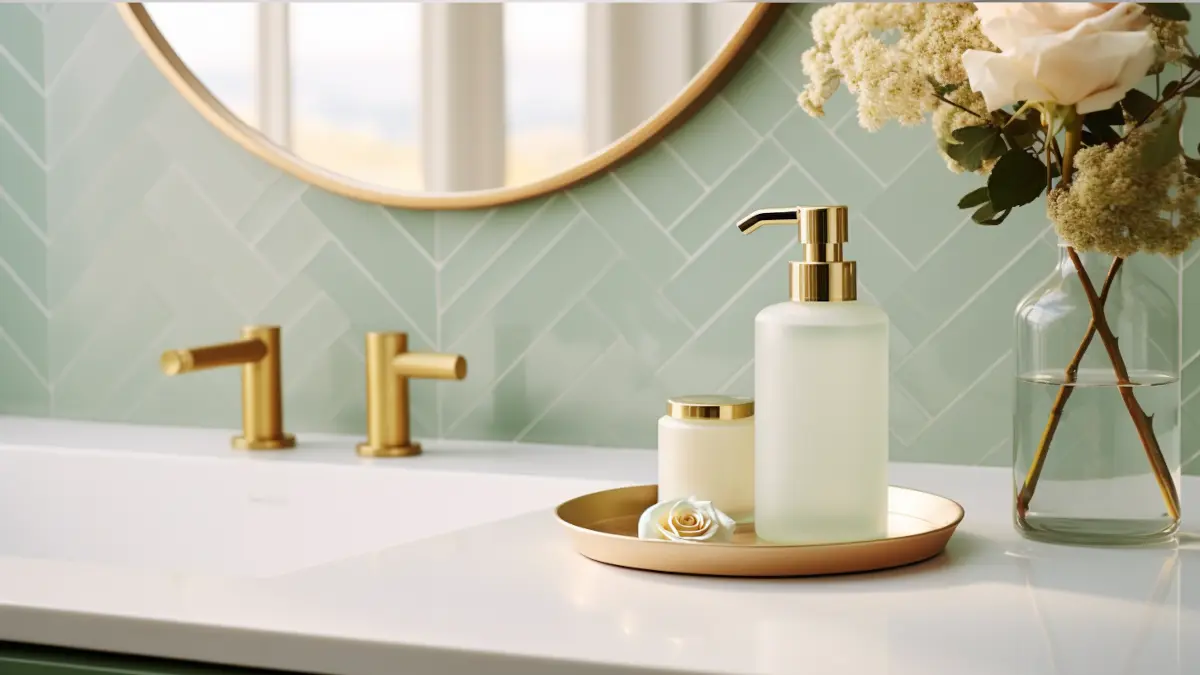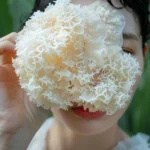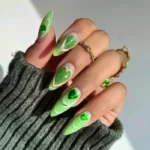Since I started consulting the internet for skincare research, every skincare sub has at least one person explaining their initial tretinoin purge phase when extolling their virtuous results after starting tretinoin.
Usually, it goes something like this, “At first, the purging from tretinoin was horrible, but a week later, my skin cleared up, and now it’s excellent, and my skin is so perfect I get marriage proposals from strangers. Also, I’m pretty sure I’m getting into heaven now despite not formerly being spiritually affiliated with any organized religion!”
You get the point. People get smug about passing through the tretinoin skin purge. Not Crossfit smug, but quite pleased with themselves.
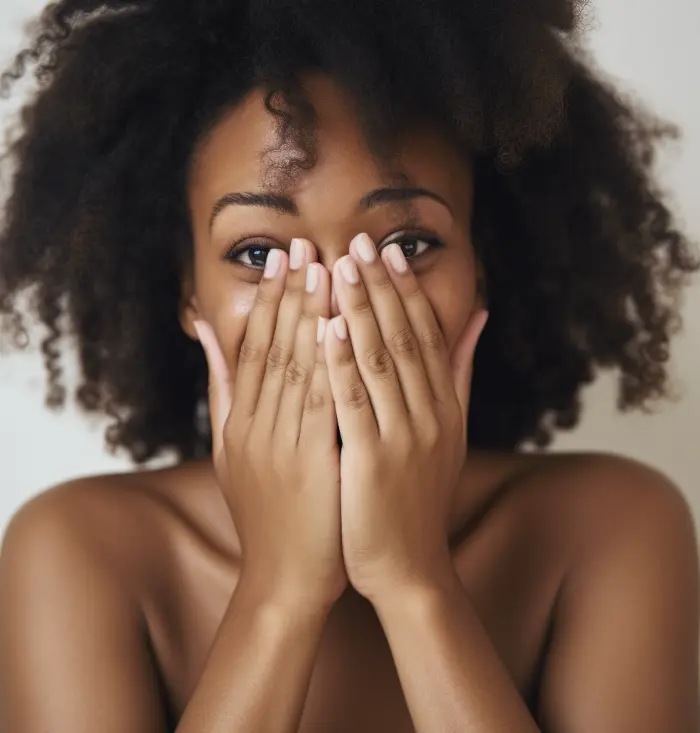
I, however, come from the school of breakout.
If my skin is having a bad reaction to something, this product is not for me. Even the instructions on almost any topically applied product tell you to discontinue use if you experience adverse reactions. It seems like, I don’t know… good advice? And isn’t a breakout an adverse reaction?
So why are people toughing out to tretinoin in the hopes that on the other side of the purge, they’ll have better skin than before?
[Editor’s note: Retinoids shouldn’t be used by those who are pregnant, considering getting pregnant, or nursing. Please consult with your doctor before use.]
The Tretinoin Purge Guide:
- What Is Tretinoin?
- What Is the Tretinoin Purge?
- What Does the Tretinoin Purge Look Like?
- Tretinoin Purge Before and After Picture
- How Long Does the Tretinoin Purge Last?
- Tretinoin Purge vs. Run For the Hills Breakout
- How to Avoid a Tretinoin Purge?
- Does Everyone Purge on Tretinoin?
- Is There a Tretinoin Second Purge?
- What to Do When Purging?
- 3 Months on Tretinoin and Still Breaking Out. Is It Time to Quit Tretinoin?
- Tretinoin for Anti-Aging — Did You Purge?
- If I Stop Using Tretinoin, Will I Purge Again If I Discontinue and Then Restart It?
- Final Thoughts
What Is Tretinoin?
If you are struggling with acne, you may have heard of tretinoin as a potential treatment option.
Tretinoin is a prescription-strength retinoid from a group of compounds called retinoids, derived from vitamin A that comes in different forms, such as creams or gels.
Tretinoin works by speeding up the life cycle of skin cells, making them divide and die faster so newer, healthier cells can take their place.
Tretinoin can help unclog pores, reduce inflammation, helps the skin renew itself, treat sun-damaged skin, and improve skin texture and fine lines. In a nutshell, tretinoin improves the appearance of the skin.
Utterly New to Tretinoin?
What Is the Tretinoin Purge, aka Retinol Uglies?
According to Dr. Shereene Idriss, MD, a New York City-based board-certified dermatologist, founder of Idriss Dermatology, and creator of the PillowtalkDerm skincare brand, purging “is an adjustment period. It is a temporary moment in which, after starting either a retinoid or even a hydroxy acid, our skin has to adjust to the product”.
To understand tretinoin purging, you need first to understand the skin cycle. Purging happens because tretinoin increases the turnover of skin cells, bringing clogged pores and impurities from the lowest layer of the epidermis to the highest layer of the epidermis faster.
For adults, the process is roughly six weeks. Purging doesn’t indicate that tretinoin is not working or harming your skin. It may indicate that tretinoin clears your pores and improves your skin texture.
When you’re a child, your skin generates new cells more quickly, which is one primary reason kids are blessed with great skin and heal more rapidly from injuries. Retinoids accelerate the skin cycle, generating new cells more quickly, and your skin has an enhanced ability to heal.
However, this also means the acne cycle accelerates, meaning the impurities and bacteria underneath your skin come to the surface as acne faster.
Typically, it may take a few weeks for the acne lesion formed in your skin to reach the surface and show up on your skin.
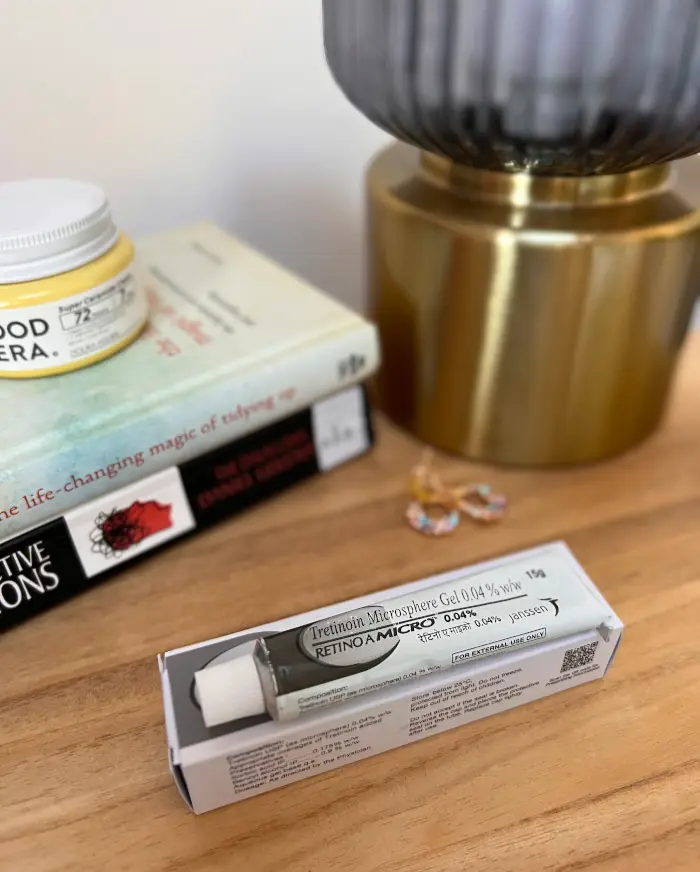
So, purging is a phenomenon by which acne lesions already formed in your skin make their way to the top of your skin faster than they usually would.
Pimples, blackheads, whiteheads, inflammatory lesions are like icebergs.
What you see on the surface is one part of the story, with the real story happening underneath the surface of the skin.
What starts off as what appears to be a clogged pore has actually been happening over time underneath the surface of the skin.
By the time this micro-comedone comes up to the surface of the skin, usually, on average, for a normal person who’s not using a retinoid or a hydroxy acid, that process can take around 4 to 8 weeks.
Dr. Shereene Idriss, MD, a New York City-based board-certified dermatologist, founder of Idriss Dermatology, and creator of the PillowtalkDerm skincare brand.
This may seem like your skin is getting worse instead of better but don’t worry. It’s not a sign that tretinoin is not working for you. It’s a sign that tretinoin is doing its job of speeding up cell turnover and bringing impurities to the surface.
The process gives the impression that you are getting new acne when, instead, you get rid of old ones more quickly.
What Does the Tretinoin Purge Look Like?
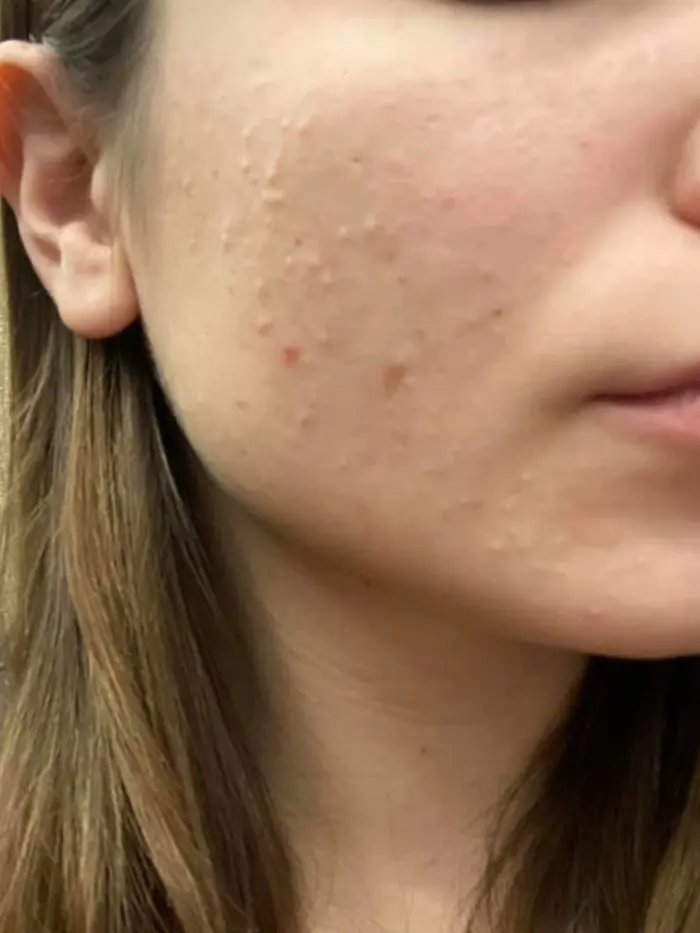
The tretinoin purge usually occurs in areas prone to clogged pores and pimples, such as the forehead, chin, and cheeks. The breakouts should be where you normally break out.
The pimples may also be more inflamed and extensive than usual, as the retinoids bring the underlying gunk to the surface.
Tretinoin Purge Before and After Pictures

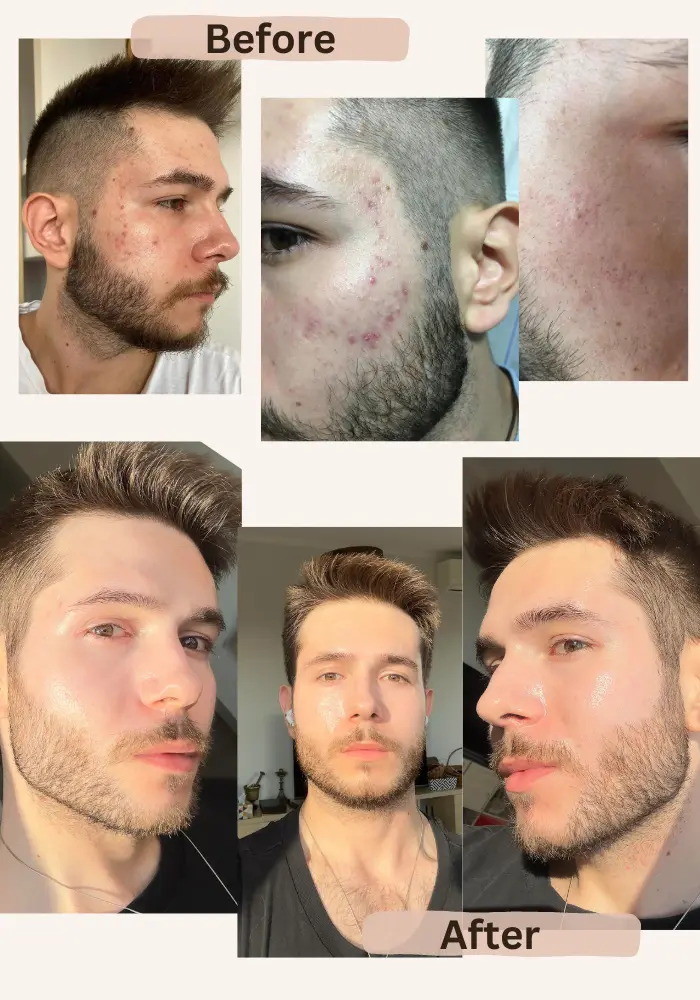
How Long Does the Tretinoin Purge Last?
According to Dr. Shereene Idriss, MD, a New York City-based board-certified dermatologist, the tretinoin purge lasts, on average, three weeks.
She further notes that “most people and most patients who come to my practice are actually experiencing skin reactions in which their skin is either super sensitive, it does not mean that they cannot tolerate it.
It just means that they have to find the right balance between efficacy and irritation in order to tolerate a product, or they simply cannot tolerate the product at all, and the product is just not sitting well with their skin.”
The good news is that once the purging phase is over, you should see noticeable improvements in your skin clarity, texture, and tone.
Tretinoin Purge vs. Run For the Hills Breakout
Purging has become a confusing catchall term for skin getting worse before it gets better. But in most situations, that’s just plain inaccurate.
It is essential to understand when the tretinoin purge is a breakout due to irritation, not a purge, which may necessitate a change in approach. Skin reaction or irritation from tretinoin is more common than you think.
Keep reading to learn more about this distinction.
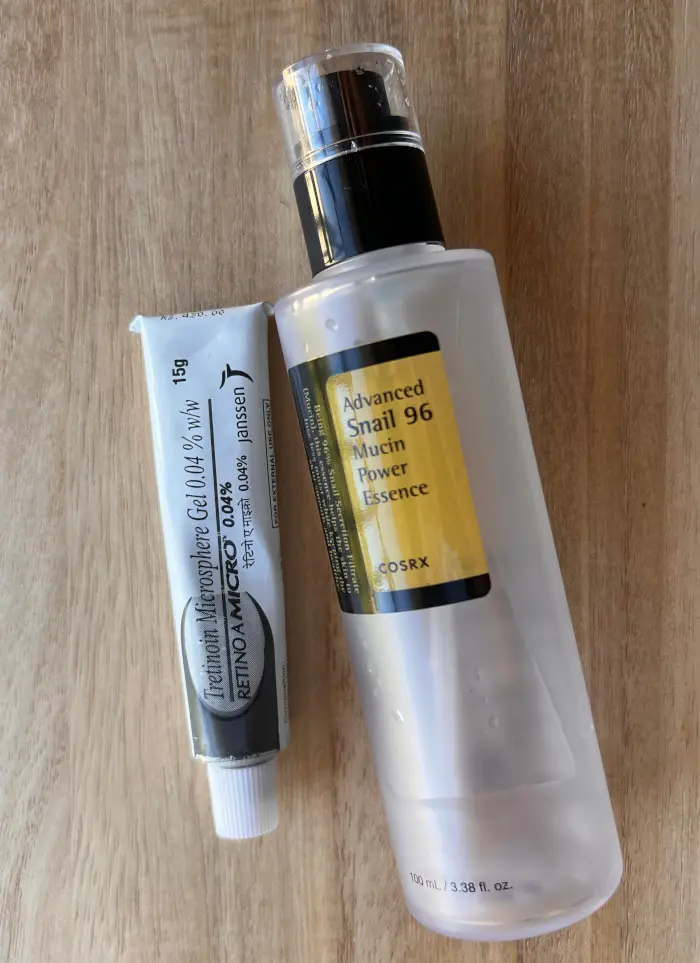
If your breakouts last longer than a month, your skin is probably reacting to the retinoid, not a tretinoin purge. If the skin tends to be irritated, red, and inflamed and doesn’t improve over time, then it is not a tretinoin purge.
At this point, whatever you’re using isn’t right for your skin. You may be sensitive to an ingredient in your tretinoin formula or something else in your skincare routine. But the more probable cause is that you use tretinoin too aggressively. You should check up with your dermatologist to discuss your best plan, changing the formulation, or changing the regimen.
Ideally, you shouldn’t deal with much irritation once you’ve used tretinoin long enough for your skin to become acclimated. Irritation is not a good thing at all after a certain point. Eventually, constant irritation will do more harm than good, and it might be better to slow down on tretinoin or moisturize your skin more.
I know first-hand how easy it is to fall into the trap of loving results and seeing if more will give me better. But I find that with tretinoin, everyone has their sweet spot where they can use it every 1-3 nights and experience little to no irritation with excellent results.
Another telltale sign of whether your skin is purging or breaking out from tretinoin is to look at the location and type of your breakouts.
Tretinoin purging, also known as Retin-A purging, occurs in areas prone to clogged pores and pimples, such as the forehead, chin, and cheeks.
The pimples may also be more inflamed and extensive than usual, as the retinoids bring the underlying microcomedones (tiny clogged pores) to the surface.
On the other hand, if you are experiencing breakouts in areas where you normally don’t have acne, such as the temples, jawline, or neck, you may be allergic to retinoids or other ingredients in your skincare product.
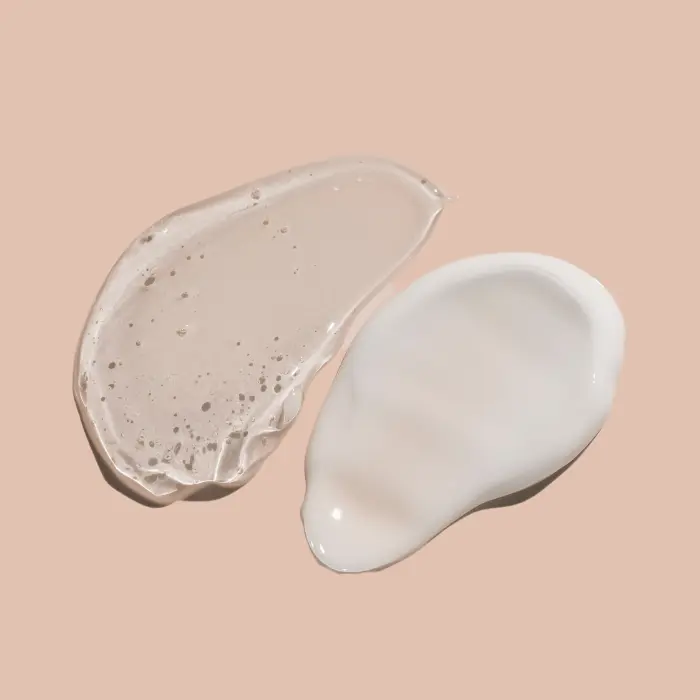
For instance, I always know something’s up when I get blemishes on my clear cheeks. The breakouts may also appear as small, red bumps that itch or burn.
Moreover, this study shows a purge should only be a 10-12% increase in your existing acne. What determines a purge is the concentration of either the retinoid or the hydroxy acid, plus the actual pH of the formulation and how that product is made.
If you are not sure whether your skin is purging or breaking out, it is best to consult your dermatologist before continuing or stopping your retinoid treatment. They can help you determine the cause of your breakouts and advise you on managing them.
The tretinoin purge can last from four to eight weeks, depending on your skin type and the strength of your retinoid product.
How to Avoid a Tretinoin Purge?
If the tretinoin purge is bound to happen to you, it cannot be avoided, nor should you want to avoid it because you’re just dealing with your existing problems faster. Most commonly, though, irritation from misusing tretinoin is confused for tretinoin purge.
What you can do is avoid irritation, which is extremely common when starting tretinoin. Irritation can cause breakouts and worsen them, as can dehydrated skin.
- Have a healthy moisture barrier when you start tretinoin and focus on moisturizing;
- Buffer tretinoin;
- Start with a low tretinoin strength (0.025%) and gradually increase the frequency of use over time.
- Stop all chemical exfoliants (AHA & BHA) before starting tretinoin so you don’t overdo it and damage your moisture barrier. Also, chemical exfoliants can cause skin purging because they are also surfacing existing clogs underneath the skin.
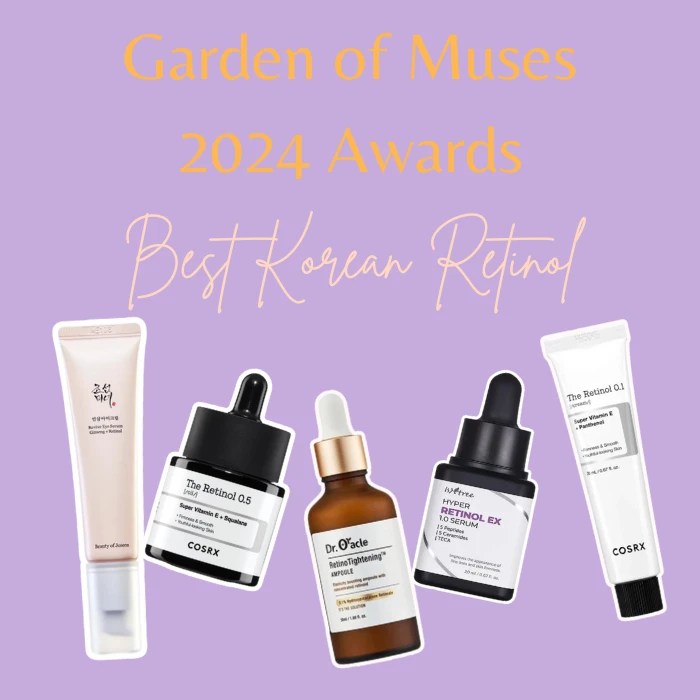
Does Everyone Purge on Tretinoin?
No, gods favor a select few in the group of Tretinoin users. It depends on your skin type, the severity of your acne, and how your skin reacts to tretinoin.
Tretinoin purging can occur if you have closed comedones and are acne-prone; otherwise, it’s not a concern. Purging is existing acne progressing more rapidly because of the change in skin cell turnover rate. If you weren’t going to break out anyway, then there’s no acne to surface more rapidly.
If you start tretinoin to treat acne, it might be advisable to get a formulation combining tretinoin, clindamycin, or any other antibiotic for topical use. Those formulations are often gel; the antibiotic can help mitigate the tretinoin purge and even shorten its duration.
Acne Prone? Here are The Best COSRX Products for Oily, Acne-Prone Skin
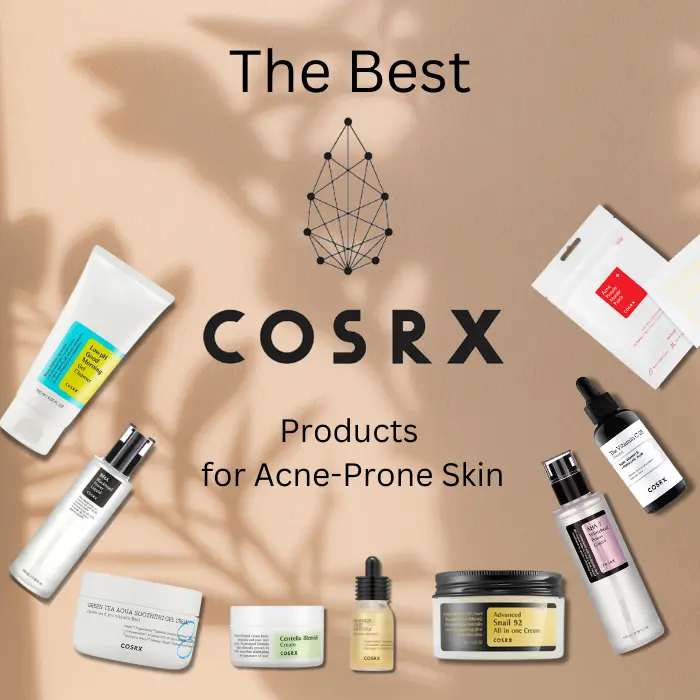
Purging can also occur if you start with really textured skin. Tretinoin will increase cell turnover and bring up everything trapped under the skin.
The tretinoin purge is also not that common; people usually misinterpret it. A study defined purging as a 10% to 20% increase in inflammatory lesions, which is a significant but not an enormous difference.
Retinoids are very irritating. Remember, irritation also causes breakouts. Go as slowly as possible and focus on hydration and gentleness. The slower you go, the less likely you are to experiment redness. Not exceptionally, even if using it every night on bare skin, many people don’t experience any purging, so YMMV.
Is There a Tretinoin Second Purge?
The tretinoin purge is, by its definition, a one-time thing. By the nature of its physiology, purging will usually last only for 6-8 weeks and will usually appear only at your usual breakout locations.

If you’re getting new waves of acne in places you usually didn’t have them, or if that acne lingers or keeps coming repeatedly, that is likely not a tretinoin purge. There is no “purging for six months” or “second, third, sixth, etc. wave of purging.”. Those would likely be a consequence of irritation.
This does not mean tretinoin will bear its full effects in 6-8 weeks. You can still get acne after that period like you used to, but it would most likely not be considered a purge.
However, once tretinoin shows its full effects after about six months, and your skin’s structure gets in order, it is vital to maintain those effects by continuing to use it.
After that, some people never have acne again, and others have a reduced amount. It’s all individual.
Current skincare routine not working?
Learn how to build a proper tretinoin skincare routine by incorporating tretinoin slowly and gently
Tretinoin Skincare RoutineWhat to Do When Purging?
Purging can be frustrating and discouraging, but remember that it is temporary and will eventually lead to clearer and smoother skin. Tretinoin has been proven effective for treating acne and improving the appearance of skin in the long term.
Follow Your Derm’s Instructions
Most prescription retinoids are combined with an antibiotic to reduce the risk of purging. The best thing to do is to be patient and consistent with tretinoin and follow your doctor’s or dermatologist’s instructions.
Step Down
If you are experiencing purging, do not stop using tretinoin or switch to another product.
Build a proper tretinoin skincare routine by incorporating tretinoin slowly and gently.
You may also want to use a gentle and non-comedogenic cleanser, moisturizer, and sunscreen to protect and soothe your skin while using tretinoin.
Avoid over-exfoliating or using harsh products that can irritate it further.
Regarding the frequency of application, keeping tretinoin applications 3 to 4 days apart is recommended initially. The concept with 72h between applications is that this gap allows you to recognize a side effect (particularly when you are just starting with tretinoin), act on it, and keep the skin exposed to tretinoin to keep retinization going.
If you started applying tretinoin every evening, you would assume that everything is going fine for the first 2 to 4 days to wake up to a destroyed skin barrier on day 5. If you apply just once a week, you will have too low exposure to tretinoin to keep retinization going. Then, when you try to increase frequency, you assume you cannot tolerate it because you start seeing side effects.
Your skin has not been exposed to tretinoin often enough to begin retinizing. Then, of course, the 72h is not set in stone; you might need to go down to every four days for a while or do two days on and three days off, but the principle is to keep a free interval to be able to react to side effects while still allowing retinization.
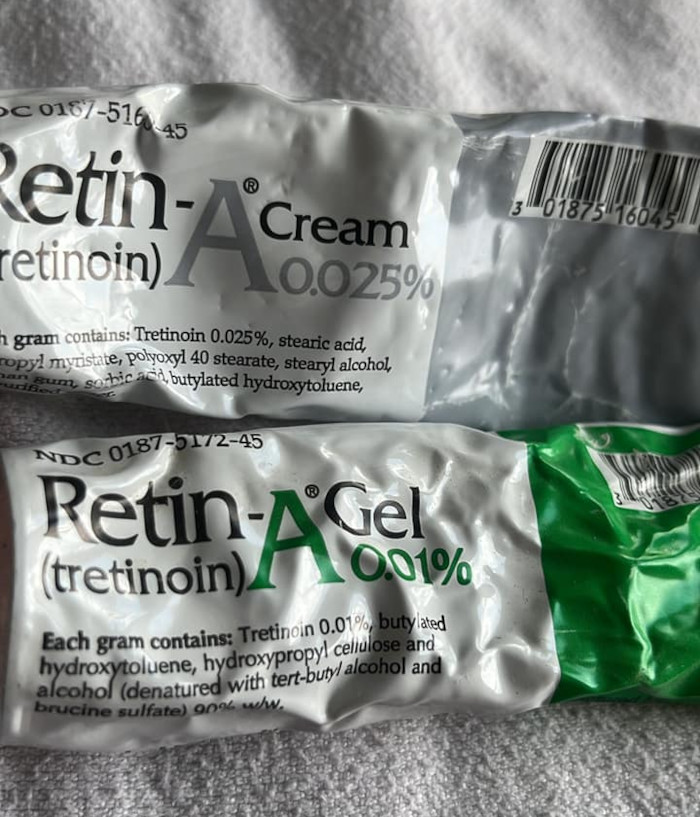
Switch from Tretinoin Gel to Tretinoin Cream or Vice Versa
Retinoids in gel form may suit acne-prone and congested skin types better than retinoids in cream form.
Sometimes, switching from Retin-A cream to Retin-A Micro can help. But, sometimes, it’s the other way around.
As always, it is best to consult with your doctor first.
Fix Your Skin’s Broken Barrier
Take care of your skin barrier. If the moisture barrier has been damaged, your skin will be very irritated, which could look like a tretinoin purge.
- Temporarily quit tretinoin;
- Although you may be used to having greasy skin, you might now need the extra moisturizer. A heavy moisturizer at night helps a ton. The heavy-duty moisturizers popular with tretinoin users are La Roche Posay Cicaplast Balm B5*, Aquaphor*, and Vaseline*;
- Try not to wash your face in the morning;
- Simplify your routine. If you must, use a soothing toner.
- Including a product that contains niacinamide can aid in reducing the effects of the tretinoin purge. Niacinamide effectively reduces inflammation and brightens the skin, and it can work in conjunction with tretinoin. Many users have experienced a noticeable improvement in skin tone when they begin using niacinamide.
(*affiliate links)
Hide Acne
Try hydrocolloid patches* to get through the tretinoin purge without picking at your skin. The drug store has them as “spot dots,” but you may try other brands. They all do the job. They’re clear and go over active acne. They work very well.
Change Pillowcases
If you are desperate, try using a fresh pillowcase every night!
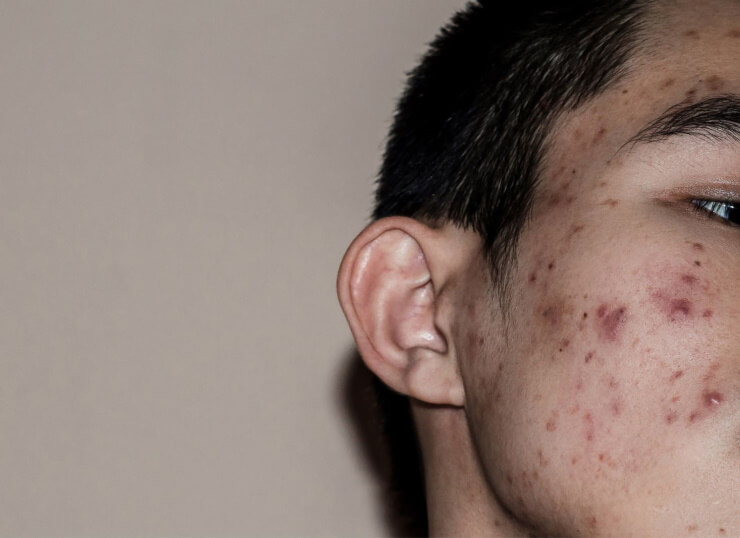
3 Months on Tretinoin, Still Breaking Out
Is it time to quit tretinoin? Treating acne is much more than just putting a routine together. If using tretinoin consistently for over three months has not improved your acne, the first thing to do is contact your medical provider to discuss options.
If you start using tretinoin to treat your acne and instead they just majorly freak your skin out, you’re just suffering from a different type of irritation now. The chronic irritation is no longer from acne. It’s from your acne treatment. So, it’s a zero-sum game for your skin health.
If you’ve been on tretinoin for months and you’re still breaking out, talk to your doctor. You shouldn’t use it without that initial consultation and suitable follow-up.
Possible strategies are:
- Change the formula from tretinoin cream to gel or the other way around. Some people experience breakouts triggered by a particular formulation. Consider switching types if you’re still breaking out after three weeks.
- Your doctor could decrease or increase your tret concentration;
- Decrease frequency. Pull back a little bit. It’s probably really intense for your skin. In the beginning, incorporate it two times a week. But note that if you use tretinoin too infrequently, the skin must undergo retinization each time. That inherently involves some irritation. If you go too slow, your skin may never acclimate.
- Add an antibiotic to the tretinoin topical preparation or as a pill to take daily for a few months;
- Add benzoyl peroxide as a wash or as a spot treatment to use in the morning (it cannot be combined with tretinoin);
- Switch to adapalene in combination with benzoyl peroxide.
- Moisturize. Moisturize. Moisturize. All skin types need moisture and hydration. Please read our guide on a good tretinoin routine.
- Simplify your routine. Adding actives to irritated skin can only exacerbate the problem. Cut out products with high alcohol content, essential oils, and fragrances.
- Stick to non-foaming, slightly acidic cleansers;
Your clinical history and how you reacted to tretinoin will guide the choice of your provider. However, skin irritation can sometimes be mistaken for “unresponsive” acne.

Tretinoin for Anti-Aging — Did You Purge?
A tretinoin purge, by definition, happens in people who have acne. You are less likely to purge if you don’t have regular acne. Still, if you use tretinoin for anti-aging, you may experience tretinoin redness and skin peeling
So, if you started tretinoin for anti-aging purposes, the tretinoin purge could be irritation from too much tretinoin. You should consider the following:
- Talk to a derm (as always, the first thing, and the most important one);
- Take it down to twice a week. There is no rush with tretinoin for anti-aging. The less you compromise your skin barrier, the better;
- Make sure you moisturize well; try the buffering/sandwich method;
- Try slugging with Aquaphor* on nights you don’t use tretinoin;
- Get married to sunblock and hats, hats, hats!
If I Stop Using Tretinoin, Will I Purge Again If I Restart It?
Maybe! This isn’t easy to predict.
I’ve learned that the tretinoin purge does not get easier just because you’ve been through it. It sucks the second and third times around. And even though I know it works out in the end, I still feel hopeless some days.
Best Skincare Products to Use If Purging
While not much can be done to stop or speed up the process of purging, we have some skincare product recommendations that will help calm the tretinoin purge and avoid inflaming it.
The products below are listed in order of the way you should include them in your routine.
1. Beauty of Joseon Radiance Cleansing Balm
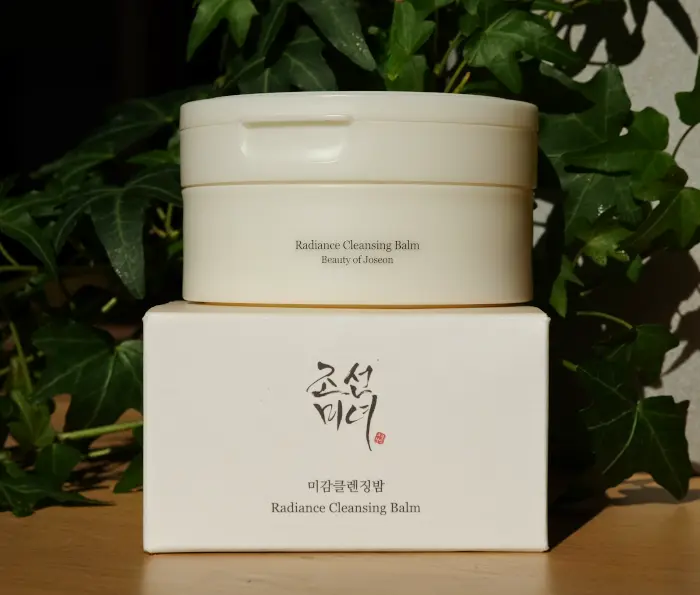
The Beauty of Joseon Radiance Cleansing Balm is an excellent first-step cleanser if your skin is acne-prone or going through the dreaded tretinoin purge.
When people first discover oil-based cleaners, they ask, ‘ Willn’t it make my skin break out even more?’ I asked the same question because my whole life (before starting to take better care of my skin), I cleansed my face multiple times a day and used an astringent toner to keep oil away. I also avoided applying moisturizing products and never wore sunscreen. But this led to even more sebum production and damaged my skin’s moisture barrier, too!
Since using the Beauty of Joseon Radiance Cleansing Balm (in my evening routine only, followed by a low-pH water-based cleanser), I’ve found that my skin has improved so much. It’s much less oily even during our hot and humid summer, and I don’t have as many clogged and enlarged pores.
So the answer is no, an oil-based cleanser won’t make you break out more. This is because the oils in your oil cleanser help pull oil-based impurities from your pores. It removes sunscreen completely and temporarily removes dirt from my pores.
Beauty of Joseon Radiance Cleansing Balm doesn’t leave an oily residue as it contains emulsifiers (surfactants). When you apply water to your face (after you’ve massaged your oil cleanser into your skin), help dissolve the oil cleanser and rinse it off your skin without leaving any oil behind. It has a glorious lightweight balm texture that emulsifies beautifully and removes all my makeup without leaving a film. It is scoopable and moldable, and a little goes a long way.
I also love the cute and minimalist packaging, which has both a pop-open lid and a twist-and-open option. The solid spatula it comes with helps you use only as much as you need.
The ingredient list is short and thankfully void of added fragrance or essential oils.
The Beauty of Joseon balm is an affordable, no-frills oil cleanser recommended for sensitive skin. Here is an in-depth review of the Beauty of Joseon Radiance Cleansing Balm.
Comedogenic ingredients: Butylene Glycol (1/5), Caprylic/Capric Triglyceride (1/5)
Malassezia/Fungal Acne Triggers: PEG-20 Glyceryl Triisostearate, PEG-10 Isostearate, Hippophae Rhamnoides (Sea Buckthorn) Seed Oil, Oryza Sativa (Rice) Bran Oil, Sorbitan Sesquioleate
Price: $14-$20
Beauty of Joseon Radiance Cleansing Balm Ingredients List (last checked 2025)
Cetyl Ethylhexanoate, Caprylic/Capric Triglyceride, PEG-20 Glyceryl Triisostearate, Synthetic Wax, PEG-10 Isostearate, Lactobacillus/Soybean Ferment Extract, Hippophae Rhamnoides Oil, Oryza Sativa (Rice) Bran Oil, Oryza Sativa (Rice) Seed Water, Avena Sativa (Oat) Meal Extract, Coix Lacryma-Jobi Ma-yuen Seed Extract, Oryza Sativa (Rice) Extract, Water, Sorbitan Sesquioleate, Glycerin, Propanediol, Butylene Glycol, 1,2-Hexanediol, Caprylyl Glycol, Ethylhexylglycerin.
Surfactant Herb Humectant/Moisturizing Ferments
2. Round Lab Birch Juice Moisturizing Cleanser
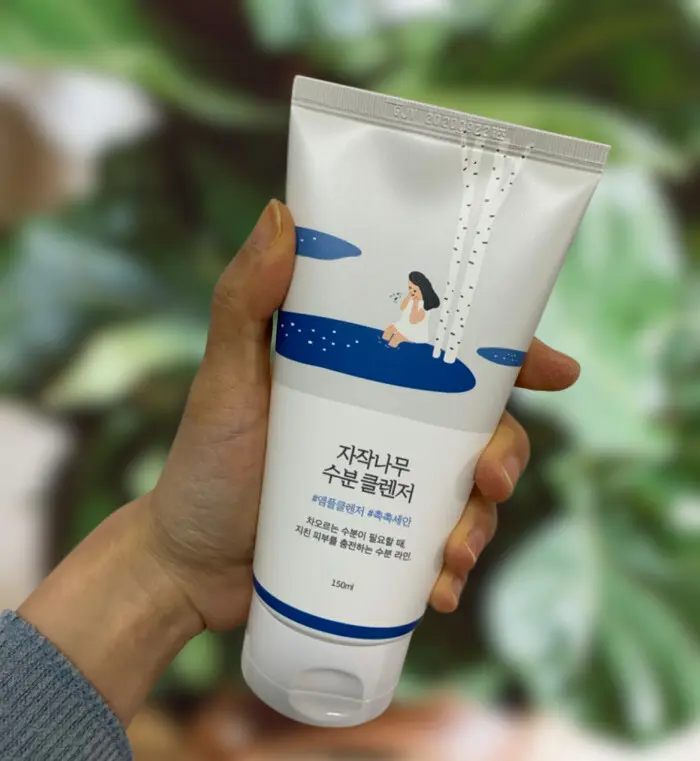
I tried Round Lab Birch Juice Moisturizing Cleanser quite a while ago, and the cleanser is still one of the most pleasant, mildly foaming gel cleansers I’ve used. My mother-in-law stole my first tube because it was so gentle on her dry skin.
Round Lab Birch Juice Moisturizing Cleanser is one of the best water-based cleansers. Also, I’ve chosen Round Lab Birch Juice Moisturizing Cleanser because it has a slightly acidic pH. When looking for the right water-based cleanser for skin that is irritated or breaking out, the most crucial factor to consider is the pH of the product. The pH of your second cleanser is essential regardless of your skin type. However, it’s vital for people with oily, acne-prone or purging. This is because cleansing affects the pH of your skin significantly.
The pH of a healthy acid mantle is a little acidic, which helps ward off bacteria and fungi and prevent trans-epidermal water loss.
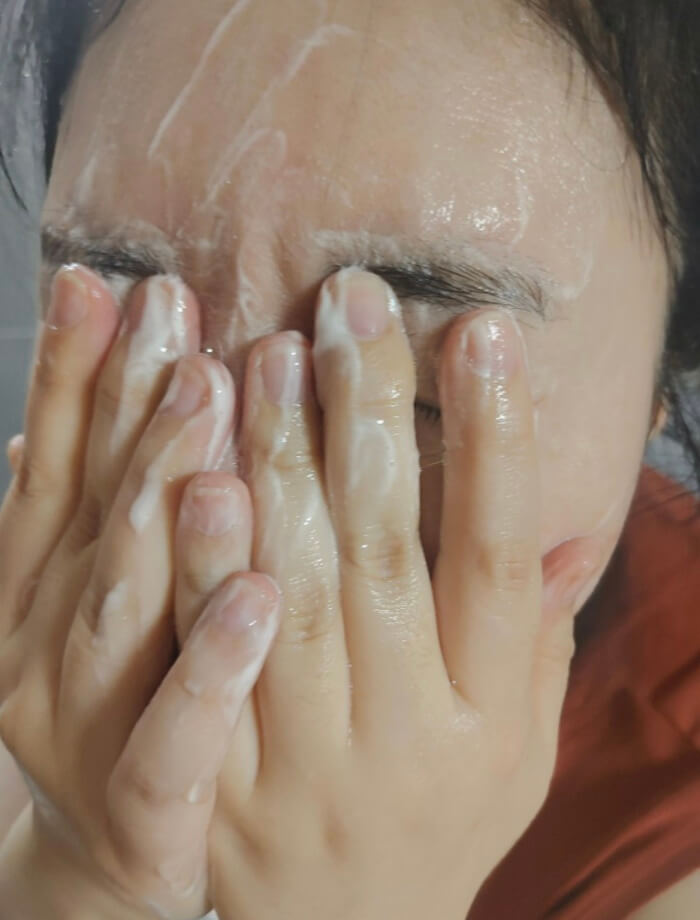
Round Lab Birch Juice Moisturizing Cleanser is sulfate-free and contains natural surfactants derived from coconut that foam beautifully to remove impurities. In addition to cleansing the skin’s surface, the Round Lab Birch Cleanser travels deep into pores to prevent buildup and blemishes, all without compromising the skin’s barrier function. It’s gentle yet effective, leaving skin clean, bright, and hydrated.
Round Lab Birch Juice Moisturizing Cleanser effectively rinses impurities without excess product or prolonged scrubbing. When rinsing, gently wet your face with warm water, massage a pea-sized amount of the cleanser over the skin in circular motions, rinse clean, and pat dry.
This is a fantastic second cleanser for all skin types that doesn’t damage the skin barrier, and I recommend it for those with sensitive, irritated, acne-prone skin.
Please read Adela’s in-depth review of the Round Lab Birch Juice Moisturizing Cleanser.
Comedogenic ingredients: Hexylene Glycol (2/5), Butylene Glycol (1/5)
Malassezia/Fungal Acne Triggers: none
Price: $12-$16
Round Lab Birch Juice Moisturizing Cleanser Ingredients List (last check 2025)
Water, Glycerin, Sodium Cocoyl Alaninate, Lauryl Hydroxysultaine, Disodium Cocoamphodiacetate, Sodium Methyl Cocoyl Taurate, Acrylate/C10-30 Alkyl Acrylate Crosspolymer, Betula Alba Juice(10,000 Ppm), Butylene Glycol, Sodium Hyaluronate, Hyaluronic Acid, Sodium Chloride, Glyceryl Glucoside, Ascorbic Acid, 1,2-Hexanediol, Artemisia Annua Extract, Anthemis Nobilis Flower Oil, Pinus Sylvestris Leaf Oil, Quillaja Saponaria Bark Extract, Caprylyl Glycol, Coco-Glucoside, Glyceryl Caprylate, Sodium Cocoyl Isethionate, Hexylene Glycol, Citric Acid, Disodium EDTA.
Surfactant Active Humectant Soothing herbs Possible irritant
Ingredients referred from the Round Lab official website.
3. COSRX Full Fit Propolis Synergy Toner
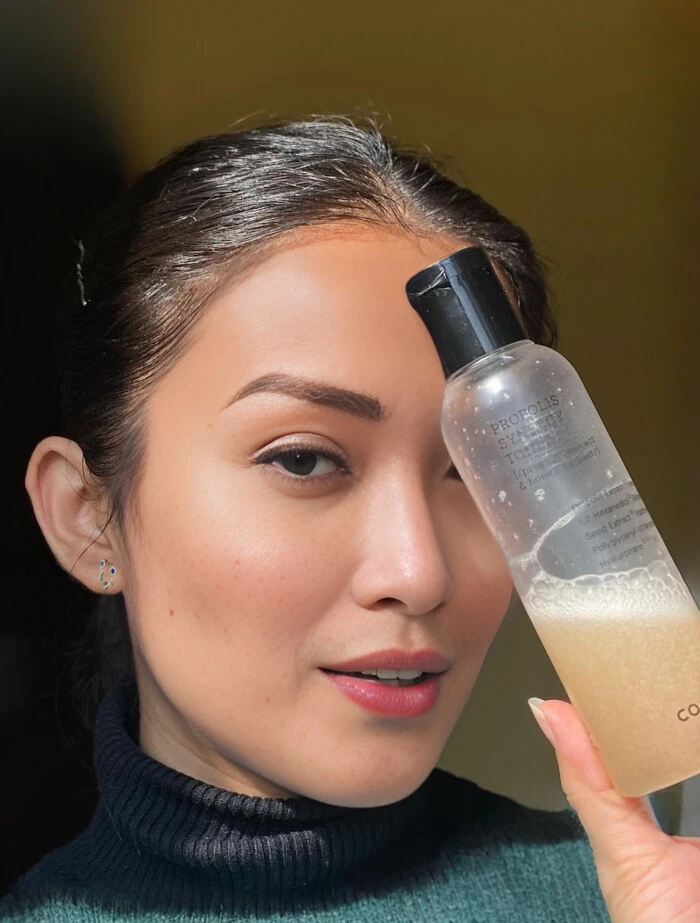
If you have acne-prone skin, propolis is an ingredient you should consider incorporating into your skincare routine. Thanks to its antibacterial and anti-inflammatory properties, it’s effective at getting rid of pimples and preventing them, too.
Also, I find this toner to be very hydrating and lovely to apply as it contains almost all humectants in the book: Honey, Butylene Glycol, Betaine, Glycerin, Panthenol, Sodium Hyaluronate.
COSRX Full Fit Propolis Synergy Toner has a thicker consistency than your usual toners but still feels like silk on the skin.
I highly recommend this for acne and to reduce the nasty effects of tretinoin.
Comedogenic ingredients: Butylene Glycol (1/5)
Malassezia/Fungal Acne Triggers: Polyglyceryl-10 Laurate, Polyglyceryl-10 Myristate
Price: $10-$13
COSRX Propolis Synergy Toner Ingredients List (last checked 2025)
Propolis Extract, Honey Extract, Butylene Glycol, 1,2-Hexanediol, Glycerin, Betaine, Cassia Obtusifolia Seed Extract, Panthenol, Polyglyceryl-10 Laurate, Polyglyceryl-10 Myristate, Ethylhexylglycerin, Sodium Hyaluronate, Hydroxyethyl Acrylate/Sodium Acryloyldimethyl Taurate Copolymer, Caprylic/Capric Triglyceride
4. Round Lab Mugwort Calming Toner
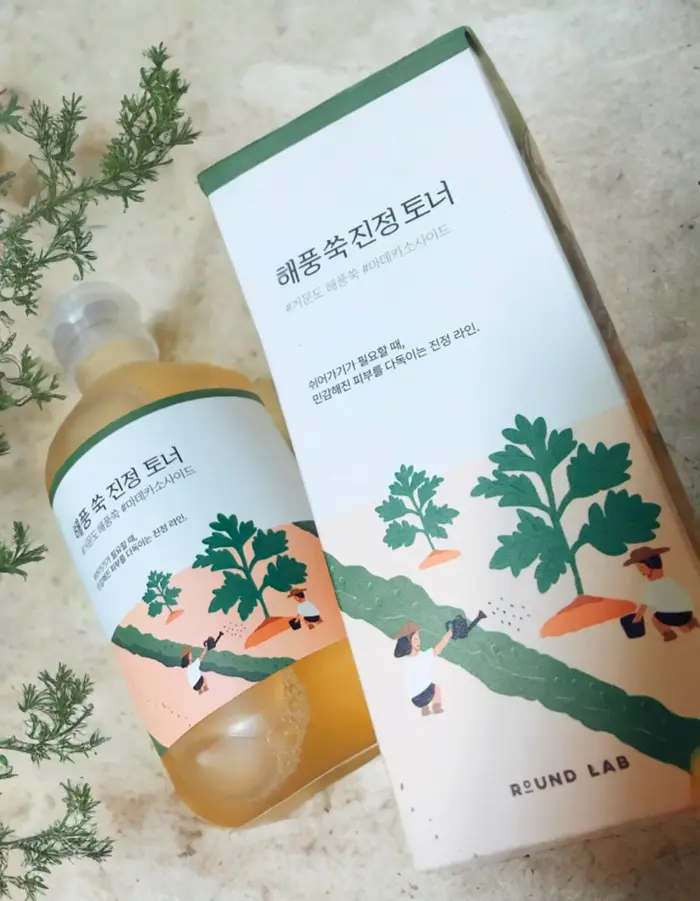
Round Lab Mugwort Calming Toner is made with Artemisia Vulgaris Extract and Artemisia Princeps Leaf Extract, which have anti-inflammatory and soothing properties. It helps calm redness, itchiness, and flakiness while hydrating and balancing your skin. I love how soft and refreshed my skin feels!
This essence contains glycerin, one of the most effective humectants used in skincare products, in addition to artemisia extracts.
This toner is especially good for those going through the tretinoin purge.
Read Diana’s Round Lab Mugwort Calming Toner review.
Price: $18-$21
Round Lab Mugwort Calming Toner Ingredients List (last checked 2025)
Purified Water, Dipropylene Glycol, Glycerin, 1,2-Hexanediol, Glycereth-26, Artemisia Vulgaris Extract (11,760ppm), Chondrus Crispus Extract, Saccharum Officinarum (Sugarcane) Extract, Panthenol, Betaine, Allantoin, Dipotassium Glycyrrhizate, Madecassoside, Xylitol, Artemisia Princeps Leaf Extract(240ppm), Chlorella Vulgaris Extract, Camellia Sinensis Leaf Extract, Salvia Officinalis (Sage) Oil, Theobroma Cacao (Cocoa) Seed Extract, Pentylene Glycol, Propanediol, Polyglyceryl-10 Laurate, Ethylhexylglycerin, Glucose, Butylene Glycol, Fructooligosaccharides, Fructose, Biosaccharide Gum-1, Dextrin, Tocopherol, Carbomer, Xanthan Gum.
Ingredients referred from the Round Lab official website.
Humectant/Moisturizing Active Herb Brightening
5. I’m From Mugwort Sheet Mask
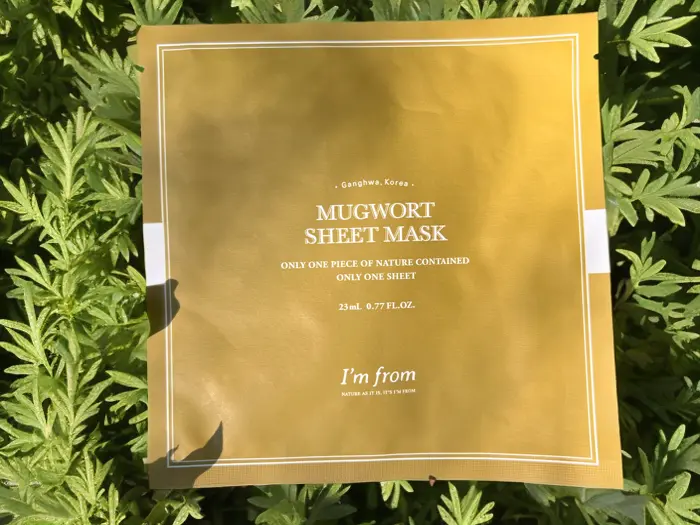
Do you know when you sometimes try foods from other cultures with scents or tastes of textures different from what you may be used to? You may be hesitant to try a particular dish or food at first, but once you do and try to understand some of the culture around it, you enjoy it.
But please don’t let this deter you from trying something that can do wonders for your skin! Like the brand’s mugwort essence, the mugwort used in this mask is cultivated on Ganghwa Island in Korea.
Notable ingredients include Cordyceps sinensis extract, a mushroom with anti-inflammatory, skin-brightening, and anti-aging properties.
I’m From Mugwort Sheet Mask, the ultimate savior for the tretinoin purge. It has ten essential ingredients, with Mugwort as its main ingredient. This soothing mask will calm, hydrate, and relax the skin.
I am putting it on after a long, stressful day. It sounds like heaven! The I’m From Mugwort Sheet Mask can hydrate your skin and is especially good for red and inflamed skin.
You can find I’m From Mugwort Sheet Mask Review here.
Price: $2-$4
I’m From Mugwort Sheet Mask Ingredients List (2025 last checked)
Artemisia Princeps Extract, Butylene Glycol, Glycerin, Methylpropanediol, Cordyceps Sinensis Extract, 1,2-Hexanediol, Caprylyl Glycol, Allantoin, Zanthoxylum Piperitum Fruit Extract, Usnea Barbata (Lichen) Extract, Dipotassium Glycyrrhizate, Panthenol, Pulsatilla Koreana Extract, Carbomer, Arginine.
Humectant/Moisturizing Active Herb Brightening
6. Benton Aloe Propolis Soothing Gel
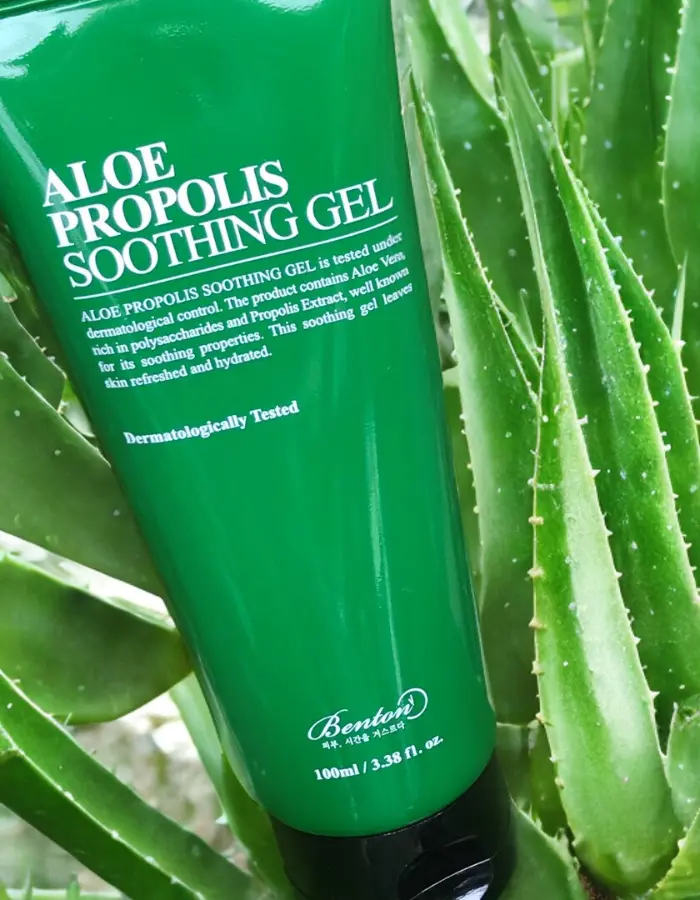
The Benton Aloe Propolis Soothing Gel is a favorite among aloe vera skincare products. Bonus: It also contains bee propolis and was recently reformulated with Houttuynia Cordata, aka heartleaf! Aloe and heartleaf have amazing anti-inflammatory properties to soothe redness and the tretinoin purge.
I recommend you try this very lightweight, non-comedogenic gel moisturizer.
Price: $16-$19
Benton Aloe Soothing Gel Ingredients List (last check 2025)
Aloe Barbadensis Leaf Juice(80%), Propolis Extract(83,320ppm), Pentylene Glycol, Butylene Glycol, 1,2-Hexanediol, Glycerin, Aloe Barbadensis Leaf Extract(4,000ppm), Betaine, Aqua (Water), Portulaca Oleracea Extract, Allantoin, Houttuynia Cordata Extract, Psidium Guajava Fruit Extract, Schisandra Chinensis Fruit Extract, Perilla Ocymoides Leaf Extract, Acorus Calamus Root Extract, Citrus Paradisi (Grapefruit) Fruit Extract, Caprylyl Glycol, Acrylates/C10-30 Alkyl Acrylate Crosspolymer, Arginine.
Ingredients referred from bentoncosmetics.com
Moisturizing/Humectant Herbal Fragrance
7. Numbuzin No.1 Clear Filter Sun Essence
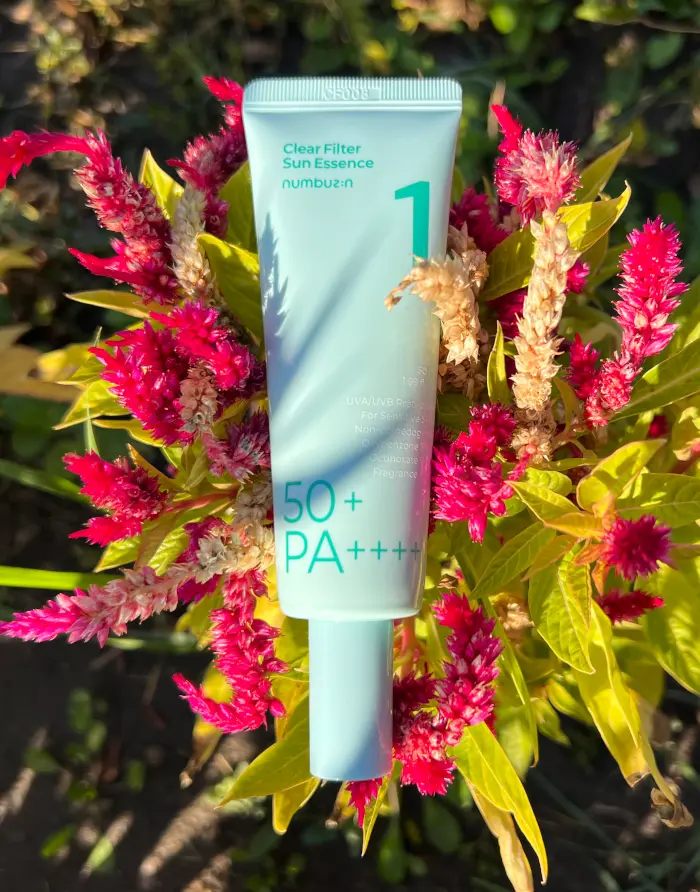
Whether you’re purging or breaking out, you still need sunscreen. Especially when on tretinoin, you should never skip sunscreen. So, choose a sunscreen you enjoy using.
The Numbuzin No.1 Clear Filter Sun Essence was launched recently (2023) and is one of the best chemical sunscreens. Korean skincare products are all about hydration, from the first to the last step of the routine. This is why I have chosen this feather-like sun serum, which feels extremely lightweight. It doesn’t leave a white cast and has a dreamy, silky finish!
If you wish to read more, here is an in-depth review of the Numbuzin No.1 Clear Filter Sun Essence.
Price: $13-$19
Numbuzin No.1 Clear Filter Sun Essence Ingredients List (product launched in 2023)
Glycyrrhiza Glabra (Licorice) Root Water (20.55%), Centella Asiatica Extract (15%), Houttuynia Cordata Extract (14.25%), Purified Water, Dibutyl Adipate, Propanediol, Butyloctyl Salicylate, Ethylhexyl Triazone, Terephthalylidene Dicamphor Sulfonic Acid, Polymethylsilsesquioxane, Niacinamide, Tromethamine, Polyglyceryl-3 Distearate, 1,2-Hexanediol, Pentylene Glycol, Diethylamino Hydroxybenzoyl Hexyl Benzoate, Cetearyl Alcohol, Caprylyl Methicone, Polysilicone-15, Melia Azadirachta Leaf Extract, Coccinia Indica Fruit Extract, Eclipta Prostrata Extract, Melia Azadirachta Flower Extract, Anastatica Hierochuntica Extract, Hyacinthus Orientalis (Hyacinth) Extract, Polygonatum Officinale Rhizome/Root Extract, Lycium Chinense Fruit Extract, Velvet Extract, Ophiopogon Japonicus Root Extract, Polygonum Multiflorum Root Extract, Astragalus Membranaceus Root Extract, Atractylodes Lancea Root Extract, Laminaria Japonica Extract, Ulmus Davidiana Root Extract, Aloe Barbadensis Leaf Extract, Viola Mandshurica Flower Extract, Dioscorea Japonica Root Extract, Sodium Hyaluronate, Glyceryl Stearate, Bis-Ethylhexyloxyphenol Methoxyphenyl Triazine, Potassium Cetyl Phosphate, Butylene Glycol, Methylpropanediol, Carbomer, Acrylate/C10-30 Alkyl Acrylate Crosspolymer, Glyceryl Stearate Citrate, Ethylhexylglycerin, Xanthan Gum, Adenosine, Polyether-1, Madecassoside, Biosaccharide Gum-1, Glycerin, Dimethylsilanol Hyaluronate, Hydrolyzed Sodium Hyaluronate, Hydrolyzed Hyaluronic Acid, Potassium Hyaluronate, Hyaluronic Acid, Sodium Hyaluronate Crosspolymer, Hydroxypropyltrimonium Hyaluronate, Sodium Hyaluronate Dimethylsilanol, Sodium Acetylated Hyaluronate.
Brightening Herbal Surfactant Sun filter Active Hydrating/Moisturizing
Final Thoughts on the Tretinoin Purge
In the beauty world, we can get so excited by the cosmetic effects of tretinoin that we can forget that they are medicine, not cosmetics. Whether or not you use a prescription-only cream like a retinoid should be discussed with your primary care doctor or dermatologist. The decision should be based on your skin health and nothing else.
For example, one of the primary reasons the medical establishment takes acne so seriously is because it represents a chronic irritation to the skin. Chronic irritation is lousy news anywhere in the body and is just as detrimental to skin health.
The tretinoin purge is not as common as you would think. Not every breakout is a purge.
Tretinoin purging happens because tretinoin increases the turnover of skin cells and brings up all the dirt, oil, and bacteria trapped in the pores to the surface, causing more breakouts than usual. The tretinoin purge usually lasts for around three weeks. Although tretinoin proves to be highly effective in treating acne in the long run, the initial few weeks or even months of use can be disheartening and demanding.
Skin purging can be minimized by starting with a low concentration of tretinoin, applying it sparingly, using a gentle cleanser and moisturizer, wearing sunscreen daily, and being patient and consistent with tretinoin.
Ask your doctor or dermatologist for advice if you have any questions or concerns about the tretinoin purge.
Show Me Proof
- Del Rosso, James Q., and F. A. O. C. D. Tretinoin. “Retinoid-induced flaring in patients with acne vulgaris: does it really exist.” J Clin Aesthet Dermatol 1, no. 1 (2008): 41-43.
- Schmidt, Nicholas, and Eugene H. Gans. “Tretinoin: a review of its anti-inflammatory properties in the treatment of acne.” The Journal of clinical and aesthetic dermatology 4, no. 11 (2011): 22.
